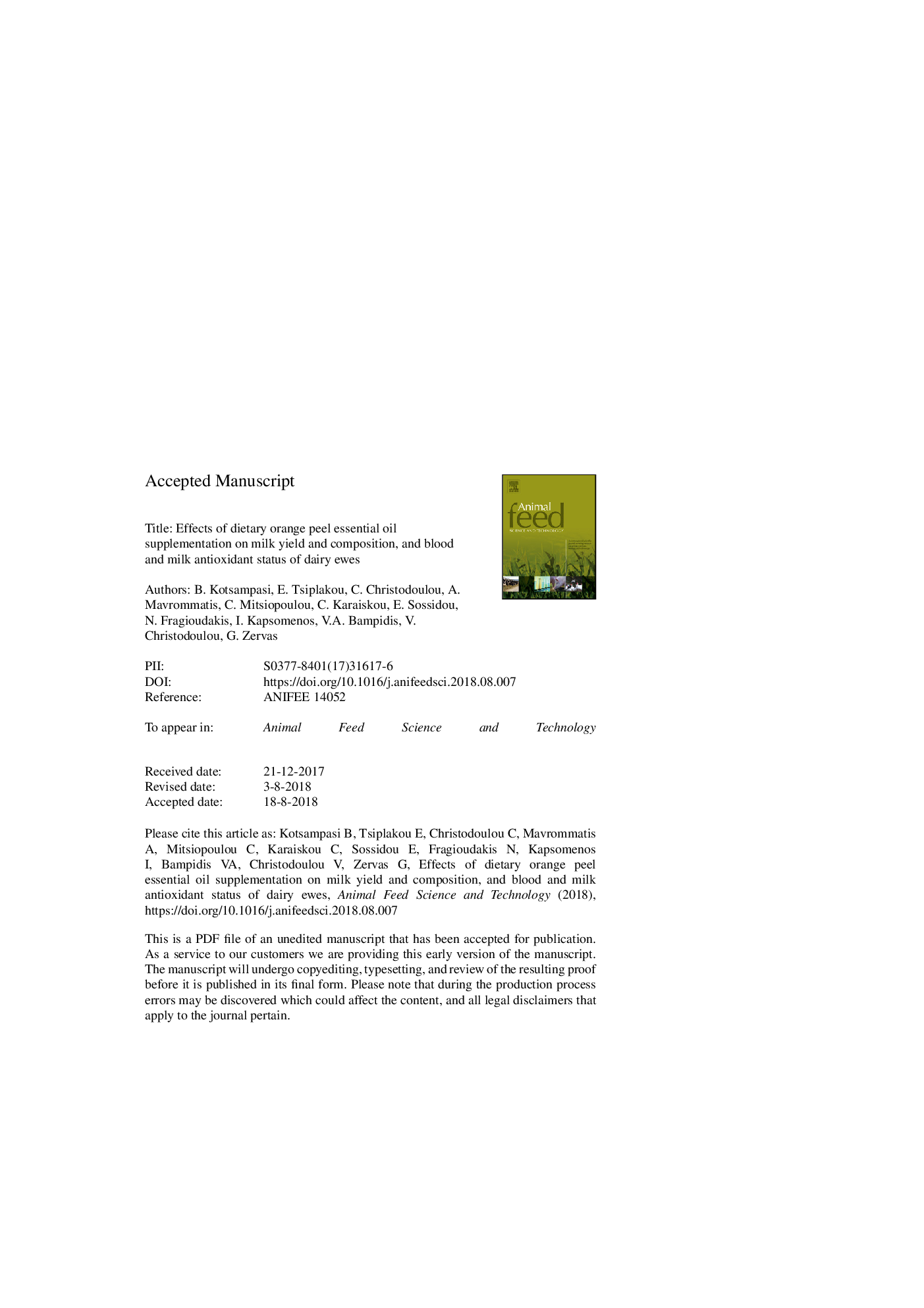| کد مقاله | کد نشریه | سال انتشار | مقاله انگلیسی | نسخه تمام متن |
|---|---|---|---|---|
| 8973671 | 1646558 | 2018 | 43 صفحه PDF | دانلود رایگان |
عنوان انگلیسی مقاله ISI
Effects of dietary orange peel essential oil supplementation on milk yield and composition, and blood and milk antioxidant status of dairy ewes
ترجمه فارسی عنوان
اثرات مکمل اسانس روغن زیتون بر عملکرد و ترکیب شیر و وضعیت آنتی اکسیدانی شیر و شیر جوجه های لبنی
دانلود مقاله + سفارش ترجمه
دانلود مقاله ISI انگلیسی
رایگان برای ایرانیان
موضوعات مرتبط
علوم زیستی و بیوفناوری
علوم کشاورزی و بیولوژیک
علوم دامی و جانورشناسی
چکیده انگلیسی
Twenty eight lactating Chios ewes were used in an experiment to determine the effects of dietary orange peel essential oil (OEO) supplementation on milk yield, composition and fatty acid profile, as well as on antioxidant status in blood and milk. In the experiment, ewes after weaning, on day 43 postpartum, were allocated according to their milk yield and lactation number, into 4 treatment groups, being OEO0, OEO150, OEO300, and OEO450, of 7 ewes each and accommodated in individual pens. For a period of 60âdays (i.e., days 43-102 postpartum), ewes were fed a concentrate (crude protein 175âg/kg, dry matter - DM basis; net energy for lactation 7.72âMJ/kg, DM basis) and alfalfa hay, with a concentrate-to-forage ratio of 57:43. The concentrate for treatment OEO0 (control) had no OEO, while that for treatments OEO150, OEO300 and OEO450 contained 150, 300 and 450âmg OEO/kg concentrate, respectively, after spraying OEO onto the concentrate of treatment OEO0. In the 60-day experimental period, DM intake quadraticaly (Pâ<â0.05) increased, being higher in OEO150 and OEO300 treatments. Milk yield, as well as 6% fat corrected milk yield, and fat and ash yields, quadraticaly increased (Pâ<â0.05), being higher in OEO150 and OEO300 treatments, whilst feed efficiency linearly increased (Pâ<â0.05). Moreover, milk protein, lactose and ash content quadraticaly decreased (Pâ<â0.05). Other yields of components, milk fat content, somatic cell counts and colony forming units were not affected (Pâ>â0.05). Milk fat fatty acid (FA) analysis showed a quadratic increase (Pâ<â0.05) in C4:0, C11:0, C14:0 and C16:0 concentrations, while a quadratic decrease (Pâ<â0.05) was observed in C17:1, C18:0, cis-9 C18:1, trans-10 C18:1, C18:2n-6c, C18:3n-3 and C20:3n-3 concentrations, with increasing dietary OEO inclusion levels. Overall, monounsaturated FA (MUFA), polyunsaturated FA (PUFA) and unsaturated FA (UFA) quadraticaly decreased (Pâ<â0.05), while saturated FA (SFA), the SFA/UFA ratio, the atherogenicity index (AI), as well as the Îâ9 desaturase activity index (C14:1/C14:0) quadraticaly increased (Pâ<â0.05), as dietary OEO supplementation increased. Blood plasma glutathione peroxidase, glutathione reductase and superoxide dismutase, and milk lactoperoxidase activity, linearly increased (Pâ<â0.05) when feeding ewes with different doses of OEO. Dietary OEO supplementation of lactating ewes, at levels up to 300âmg/kg concentrate, increased milk yield, fat yield and ash yield, but decreased milk UFA concentration and AI, whereas OEO supplementation at higher level (450âmg/kg concentrate), had no effect. Thus, OEO could be considered as a natural feed supplement in ewes' diet and make it a suitable source of functional ingredient in animal nutrition to improve animals' performance and health, as well as product quality and safety.
ناشر
Database: Elsevier - ScienceDirect (ساینس دایرکت)
Journal: Animal Feed Science and Technology - Volume 245, November 2018, Pages 20-31
Journal: Animal Feed Science and Technology - Volume 245, November 2018, Pages 20-31
نویسندگان
B. Kotsampasi, E. Tsiplakou, C. Christodoulou, A. Mavrommatis, C. Mitsiopoulou, C. Karaiskou, E. Sossidou, N. Fragioudakis, I. Kapsomenos, V.A. Bampidis, V. Christodoulou, G. Zervas,
